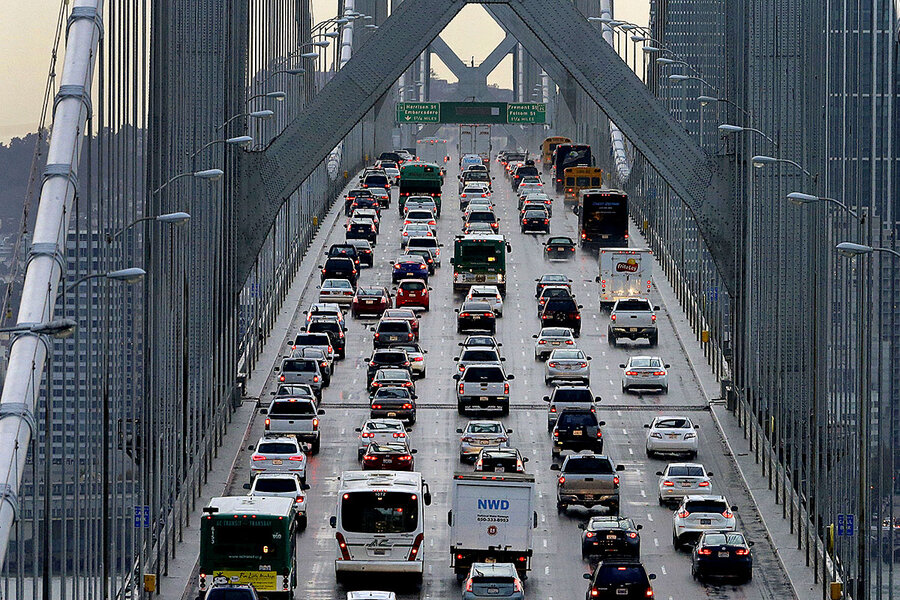Why carmakers are revving for regulation
Loading...
The auto industry is learning the hard way: When facing tough times, lighter regulation isn’t necessarily a panacea. Carmakers are already confronting a cooling global economy, a trade war, and an era of destabilizing changes, such as the looming rise of autonomous cars. Now add this: uncertainty over fuel-economy regulations that the Trump administration is trying to loosen.
What would change?
Here’s the current setup. The Obama administration boosted the nation’s Corporate Average Fuel Economy (CAFE) target to 54.5 mpg. The national fuel efficiency average is supposed to hit that level by 2025.
Why We Wrote This
Often the assumption is that “deregulation” is what any industry prefers. Sometimes regulatory certainty and geographic consistency are bigger priorities for business leaders.
The Trump administration’s plan would hold CAFE and greenhouse gas standards at 2020 levels of about 37 mpg. The result could keep manufacturing and purchase costs down, but would mean higher gasoline costs, and slower environmental progress for a sector that is the largest emitter of pollutants contributing to climate change.
The Trump plan was first proposed last year but is still in a period of final review.
What do automakers say?
Carmakers had originally asked for a bit of easing in the Obama targets. But the administration is taking an ax rather than a paring knife to the rules.
Why is that a problem in Detroit? First, businesses prefer certainty. Instead, next up could be litigation over whether the regulatory about-face is justified.
Carmakers themselves acknowledge the reality of climate change and know that the vast majority of governments around the world expect them to help address it. (Trump environmental and transportation officials argue that aggressive emissions targets aren’t necessary and that easing them will help more people buy safer cars.)
Another factor: California has a long-standing waiver to set its own fuel-economy standards, which other states can choose to follow instead of federal rules. The Obama administration plan represented a bargain in which federal and California plans became harmonized. Maintaining one national plan is a top priority for the industry as it results in fewer quandaries over how to serve a bifurcated U.S. market. The Trump administration says it also wants one national plan. Its threat to eliminate California’s waiver looks set to become another point of litigation.
“The uncertainty is really hard on the auto industry,” with its long planning cycles, says Jessica Caldwell, an executive director of industry analysis at Edmunds in Santa Monica, California.
What are the latest moves?
California and numerous other states are suing the Trump administration over its plan to weaken the rules. Carmakers have sought unsuccessfully to nudge the president to bargain with California.
Then in July, amid the federal-state impasse, four major carmakers representing 30% of the U.S. market struck their own bargain directly with California. They’ll keep aiming toward the Obama targets, in a slightly eased form, for their entire nationwide fleets. In effect these firms – Ford, Honda, BMW, and Volkswagen – are casting a vote of no confidence in the Trump approach. Other carmakers might end up tagging along. And Canada, currently aligned with the Obama rules, might join in, too.
President Donald Trump has lashed out on Twitter at “foolish executives” who aren’t siding with him. Meanwhile two key federal officials on the issue have recently left their jobs.
Why does all this matter?
For carmakers, the regulatory uncertainty will affect what is already an anxious time for the industry. Firms face daunting strategic choices about new technologies. Some of the investments will transform transportation. Others will flop. Survival for storied auto brands is far from assured.
“The fuel-economy [regulation] system has been a critical energy security policy for the United States since the first oil embargo” in the 1970s, says Robbie Diamond, president of Securing America’s Future Energy, an advocacy group in Washington. Yet “talking about regulation in a vacuum from the global auto sector and the technological shifts and revolutions that we’re seeding is a bit of a bland discussion.”
The industry-rattling upheavals include the dawn of autonomous vehicles and a possible shift toward shared ownership of vehicles rather than a car or two in every driveway. The new technologies also include ones that could allow regulators to pursue faster, not slower, fuel-economy improvements, Mr. Diamond says.
On climate change regulations, the outcome will affect the pace of a transition that is still in its infancy. Against the goal espoused by many climate scientists of zero net carbon emissions by 2050, “we’re nowhere near on the path we really need to be going,” says Dave Cooke, an automotive expert at the Union of Concerned Scientists in Washington.
As a huge market, the U.S. can influence auto regulations and trends in other nations, too. And for consumers, steady boosts to fuel economy can mean big savings. Consumer Reports estimates that $1 spent upfront by manufacturers on fuel economy saves $3 for consumers on fuel.






